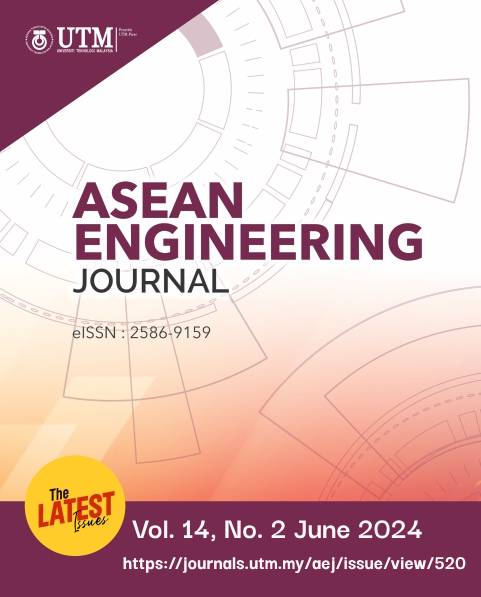DEVELOPMENT AND ANALYSIS OF A GIS-BASED CURVE NUMBER MAP OF THE PHILIPPINES
DOI:
https://doi.org/10.11113/aej.v14.21013Keywords:
Curve number, geographic information system, hydrologic loss, runoff potential, hydrologic soil groupAbstract
Stormwater management requires quantitative methods to determine objective flood risk by estimating how much rainfall becomes runoff. With the absence of a locally generated runoff coefficient database in the Philippines, the standard model for surface runoff estimation is yet to be implemented using homegrown datasets. Traditionally, the empirical method is adapted from the National Resources Conservation Service (NRCS). The method quantifies rainfall-runoff relationships underscoring the combined effects of ground cover, soil hydraulic conductivity, and antecedent runoff condition (ARC) on runoff potential via a hydrologic parameter called the Curve Number (CN). Using geographic information system (GIS) tools, the Philippine CN map is developed by preprocessing and intersecting land use and land cover (LULC) and hydrologic soil group (HSG) with the CN look-up table. It was revealed that Group C soils dominate the Philippines. New data products—three raster CN maps at 25m spatial resolution—indicated the prevalence of medium to high runoff potential. National curve numbers were 61, 78, and 89 for dry, average, and wet ARCs, respectively. The outputs of this study provide access to spatially varied local runoff potential data in GIS format thus allowing direct GIS use for the swift simulation of flood damage mitigation models, among others.
References
Thiam, E., and V.P. Singh. 2002. Space-Time-Frequency Analysis of Rainfall, Runoff and Temperature in the Casamance River Basin. Water SA. 28(3): 259-270.
United States Department of Agriculture. 2021. National Engineering Handbook: Part 650 — Engineering Field Handbook. Maryland: National Resources Conservation Service. 2: 1-36.
Hawkins, R.H., T.J. Ward, D.E. Woodward, and J.A. Van Mullem. 2009. Review of Curve Number Hydrology: State of the Practice. Journal of Hydrologic Engineering. 14(9): 6-44. DOI: https://doi.org/10.1061/(ASCE)HE.1943-5584.0000119
United States Department of Agriculture. 2002. National Engineering Handbook: Part 630 — Hydrology. Maryland: National Resources Conservation Service. 8: 1-5.
Official Gazette of the Republic of the Philippines. 2012. About Project NOAH. Available at: https://www.officialgazette.gov.ph/programs/about-project-noah accessed on 02 January 2023
Cayson, F.C., C.L. Patiño, and M.L. Flores. 2019. Runoff Estimation using SCS Runoff Curve Number Method in Cebu Island. Proceedings of the PhilGEOS x GeoAdvances 2019. Manila, Philippines.
DOI: https://doi.org/10.5194/isprs-archives-XLII-4-W19-109-2019
Geodatos. n.d. Philippines Geographic Coordinates, available at: https://www.geodatos.net/en/coordinates/philippines accessed on 17 November 2022
Chin, D.A. 2021. Deficiencies in the Curve Number Method. Journal of Irrigation and Drainage Engineering. 147(5): 1-11.
DOI: https://doi.org/10.1061/(ASCE)IR.1943-4774.0001552
Stewart, D., E. Canfield, and R. Hawkins. 2012. Curve Number Determination Methods and Uncertainty in Hydrologic Soil Groups from Semiarid Watershed Data. Journal of Hydrologic Engineering. 17(11): 1180-1187. DOI: https://doi.org/10.1061/(ASCE)HE.1943-5584.0000452
Rietz, D., and R.H. Hawkins. 2000. Effects of Land Use on Runoff Curve Number. Proceedings of the Watershed Management and Operations Management Conferences 2000. Fort Collins, Colorado. DOI: https://doi.org/10.1061/40499(2000)110
Ogden, F.L., N. Pradhan, J.E. Nelson, and C.W. Downer. 2011. Predicting Hydrologic Effects of Land-Use Change: Problems with the Curve Number Approach. Proceedings of the World Environmental and Water Resources Congress 2011: Bearing Knowledge for Sustainability. Palm Springs, California. DOI: https://doi.org/10.1061/41173(414)498
Jaafar, H.H., F.A. Ahmad, and N. El Beyrouthy. 2019. GCN250, New Global Gridded Curve Numbers for Hydrologic Modeling and Design. Scientific Data. 6(145): 1-9. DOI: https://doi.org/10.1038/s41597-019-0155-x
European Space Agency. 2018. CCI Land Cover Product User Guide version 2.4. ESA CCI LC Project, available at: https://www.esa-landcover-cci. org/?q=node/164
Ross, C.W., L. Prihodko, J.Y. Anchang, S.S. Kumar, W. Ji, and N.P. Hanan. 2018. Global Hydrologic Soil Groups (HYSOGs250m) for Curve Number-Based Runoff Modeling. Tennessee: Oak Ridge National Laboratory Distributed Active Archive Center. DOI: https://doi.org/10.3334/ORNLDAAC/1566
Merwade, V. 2019. Creating SCS Curve Number Grid using Land Cover and Soil Data. Indiana: Purdue University. 1-10.
Karnika, D., and M.P. Tripathi. 2020. Preparation of Curve Number Map for Hydrologic Simulation using GIS and HEC-Geo-HMS Model. International Journal of Current Microbiology and Applied Sciences. 9(3): 3264-3270. DOI: https://doi.org/10.20546/ijcmas.2020.903.374
Dag-uman, D.K. 2022. 2020 Land Cover Map of the Philippines, available at: https://www.geoportal.gov.ph. Taguig City: National Mapping and Resource Information Authority.
Multi-Resolution Land Characteristics Consortium. 2001. National Land Cover Database Class Legend and Description, available at: https://www.mrlc.gov/data/legends/national-land-cover-database-class-legend-and-description accessed on 24 January 2023)
Contreras, S. 2013. General Soil Map of the Philippines, available at: https://www.geoportal.gov.ph. Quezon City: Bureau of Soils and Water Management. Accessed on 26 June 2023
United States Department of Agriculture. 2009. National Engineering Handbook: Part 630 — Hydrology. Maryland: National Resources Conservation Service. 7: 1-5.
Carating, R.B., R.G. Galanta, and C.D. Bacatio. 2014. The Soils of the Philippines. Quezon City: Bureau of Soils and Water Management. 1-346. DOI: https://doi.org/10.1007/978-94-017-8682-9
Quijano, I.P., J. Valenzuela, R.S. Caredo, C. Patiño, and J. Sinogaya. 2015. Vulnerability Assessment of Government Buildings in Sagay City
through Flood Modeling and Mobile GIS, available at: https://citeseerx.ist.psu.edu/viewdoc/download?doi=10.1.1.741.5748&rep=rep1&type=pdf accessed on 13 June 2023
















